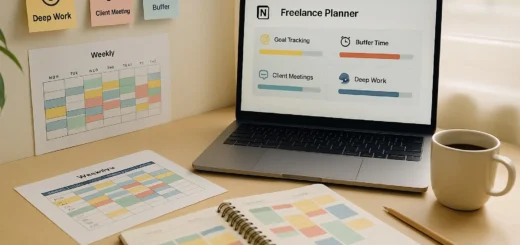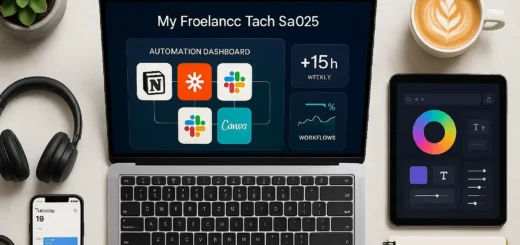Smart Investment Strategies for Freelancers: Build Financial Security with Irregular Income

Introduction
When I started freelancing seven years ago, my financial life was pure chaos. One month I’d earn $8,000 from multiple projects, the next I’d scrape by on $2,000 while waiting for invoices to clear. This feast-or-famine cycle and the resulting financial strain taught me that investment strategies for freelancers require a fundamentally different approach than traditional employment investing.
Today, I generate over $9,000 monthly in passive income through dividends, digital products, and strategic investments. This transformation didn’t happen overnight—it required developing smart investment tips for freelancers that account for our unique financial challenges. In this comprehensive freelancer’s guide, I’ll share the exact strategies that helped me build a $487,000 portfolio while maintaining the freedom and flexibility of freelance work.
Why Investment Strategies for Freelancers Differ: Managing Irregular Income & Financial Stability
Freelancers face distinct challenges in managing finances with an irregular income that demand specialized investment strategies:
The Freelancer’s Financial Reality: Irregular Income & Missing Benefits
Income Volatility: While employees enjoy predictable paychecks, freelancers experience income fluctuations of 30-70% between months.. This volatility makes traditional “invest 15% of each paycheck” advice impractical.
Missing Benefits: Consider what employees receive automatically:
- 401(k) matching (average 3-6% of salary = $3,000-6,000 annually on $100k income)
- Subsidized health insurance (worth $5,000-15,000 yearly)
- Paid time off (10-20 days = $2,000-4,000 value)
- Disability and life insurance coverage
Tax Complexity: Freelancers pay both employer and employee portions of Social Security and Medicare taxes (15.3% total), requiring more sophisticated tax planning within our investment strategies for freelancers.
A 2024 Freelancers Union study revealed that only 28% of freelancers have retirement savings, compared to 67% of traditional employees. This gap highlights why developing robust financial planning for freelancers isn’t optional—it’s essential to achieve financial stability and long-term survival.
Step 1: Build an Emergency Fund and Financial Foundation Before Investing
Before exploring how freelancers can invest money, establish these critical foundations:
Create a Bulletproof Emergency Fund for Freelancers
Traditional advice suggests 3-6 months of living expenses. For freelancers, I recommend 6-9 months minimum as a stronger financial safety net. Here’s my proven approach:
Month 1-2: Track Every Dollar
- Document all expenses for 60 days
- Identify essential vs. discretionary spending
- Calculate your true monthly survival number
Month 3-4: Open High-Yield Savings
- Research accounts offering 4%+ APY
- Consider online banks for better rates
- Automate weekly transfers, even if just $50
Current Top High-Yield Options (2025):
| Bank | APY | Minimum Balance | Best Feature |
|---|---|---|---|
| SoFi Checking | 4.60% | $0 | Early direct deposit |
| Capital One 360 | 4.25% | $0 | Excellent mobile app |
| Ally Bank | 4.20% | $0 | Bucket feature for taxes |
| Marcus by Goldman Sachs | 4.15% | $0 | No fees ever |
| Discover Online | 4.00% | $0 | Cashback debit card |
Optimize Your Business Structure for Better Tax & Financial Planning
The right business entity can save thousands in taxes, freeing more money for investments:
Sole Proprietorship → LLC: Basic liability protection, minimal tax advantages LLC → S-Corporation: Significant self-employment tax savings above $60,000 income
Real Example: On $100,000 net income, an S-Corp saved me $7,400 in self-employment taxes—money I immediately invested in my Solo 401(k).
Implement the Income Smoothing System for Stable Freelance Income
This system revolutionized my ability to maintain consistent investment strategies for freelancers:
- Business Checking Account: All client payments deposited here
- Tax Savings Account: Automatically transfer 25-30% of each deposit
- Income Smoothing Account: Transfer remaining funds
- Personal Checking: Pay yourself consistent bi-weekly “salary”
- Investment Accounts: Automate contributions from your salary
This structure ensures you can invest consistently regardless of payment timing and regardless of market conditions, making freelance money management tips actually implementable.
Smart Investment Tips for Freelancers: Core Strategies to Invest Money Wisely
Strategy 1: Maximize Tax-Advantaged Retirement Accounts (Solo 401k, Roth IRA)
Solo 401(k): The Freelancer’s Secret Weapon
The Solo 401(k) offers unmatched contribution limits and is especially suitable for self-employed individuals:
- Employee Contribution: $23,000 (2025 limit)
- Employer Contribution: Up to 25% of net self-employment income
- Total Maximum: $69,000 ($76,500 if 50+)
Calculation Example: Net freelance income: $100,000
- Employee contribution: $23,000
- Employer contribution: $25,000 (25% of $100k)
- Total tax-deferred: $48,000
- Tax savings (24% bracket): $11,520
SEP-IRA: Simpler Alternative
Easier to establish but only allows employer contributions:
- Contribute up to 25% of net income
- Maximum: $69,000 (2025)
- No employee contribution option
- Better if you have employees
Roth IRA: Tax-Free Growth
Perfect for lower-income years or young freelancers:
- $7,000 annual limit ($8,000 if 50+)
- Tax-free withdrawals in retirement
- Income phase-out starts at $138,000 (single)
- No required minimum distributions
Strategy 2: Build Multiple Investment Buckets to Diversify Your Portfolio
Successful investment strategies for freelancers require diversification across different types of investments and time horizons:
Short-Term Bucket (0-2 years): Liquidity Focus
- Purpose: Emergency fund, tax payments, business opportunities
- Allocation: 20-30% of portfolio
- Vehicles: High-yield savings, money market funds, short-term bonds
- Target Return: 3-5% annually
Medium-Term Bucket (2-7 years): Balanced Growth
- Purpose: Major purchases, business expansion, semi-retirement
- Allocation: 25-35% of portfolio
- Vehicles: Mutual funds, balanced funds, dividend ETFs, corporate bonds
- Target Return: 6-8% annually
Long-Term Bucket (7+ years): Wealth Building
- Purpose: Retirement, financial independence
- Allocation: 40-50% of portfolio
- Vehicles: Index funds, growth stocks, real estate
- Target Return: 9-12% annually
Strategy 3: Passive Income Ideas for Freelancers to Build Wealth
Transform your skills and financial products into recurring revenue streams:
Digital Product Creation
My Digital Product Journey:
- Month 1-3: Created basic Photoshop action pack ($17) → $200/month
- Month 4-6: Developed comprehensive design course ($197) → $2,000/month
- Month 7-12: Built template subscription service ($47/month) → $3,500/month
Key Success Factors:
- Start with your most requested service
- Price at 10-20% of your hourly rate
- Update quarterly to maintain relevance
- Bundle products for higher value
Strategic Affiliate Marketing
Focus on tools you genuinely use:
- Project management software (15-30% commissions)
- Design tools and plugins (20-40% commissions)
- Educational resources (30-50% commissions)
My Results: One comparison article about project management tools generates $1,200-1,800 monthly after 18 months.
Content Licensing
Transform existing work into recurring revenue:
- Stock photography/video ($0.25-5 per download)
- Template marketplaces (40-70% commission)
- Educational content platforms (50-97% royalties)
Best Investment Apps for Freelancers: Tools for Financial Planning & Money Management
The right tools make it easier to manage your finances and implement investment strategies for freelancers:
Best Portfolio Management Apps for Freelancers
Vanguard Personal Advisor Services
- Best for: Hands-off investors
- Minimum: $50,000
- Fee: 0.30% annually
- Features: Financial advisor access, automatic rebalancing
Fidelity Go
- Best for: Beginners
- Minimum: $0
- Fee: 0% under $25k, then 0.35%
- Features: Personalized planning, no-fee trades
Betterment
- Best for: Goal-based investing
- Minimum: $0
- Fee: 0.25% annually
- Features: Tax-loss harvesting, retirement planning
Specialized Financial Apps for Freelancers: Money & Budgeting Tools
Catch
- Automated tax withholding
- Benefits marketplace
- Retirement contributions
- Fee: $79/year
Perlstein
- Freelance-specific tax planning
- Quarterly payment reminders
- Deduction tracking
- Fee: Free basic, $15/month premium
Wave
- Free accounting software
- Invoice management
- Receipt scanning
- Fee: Free (paid add-ons available)
Building Wealth as a Freelancer: Advanced Strategies
The Barbell Investment Approach: Balancing Risk and Safety
This strategy balances extreme safety with calculated risk:
Safe Side (80% of portfolio):
- Index funds tracking S&P 500
- Government bonds
- High-yield savings
- Stable dividend aristocrats
Risk Side (20% of portfolio):
- Individual growth stocks
- Sector-specific ETFs
- Real estate crowdfunding
- Cryptocurrencies (max 5%)
Real Estate Investment for Freelancers: Long-Term Wealth Building
REITs: Easiest Entry Point
- Minimum investment: $100-1,000
- Average dividend yield: 3-8%
- Liquidity: Same-day selling
- Tax consideration: Dividends taxed as ordinary income
Crowdfunded Real Estate
- Platforms: Fundrise, RealtyMogul, YieldStreet
- Minimum: $500-5,000
- Returns: 8-12% targeted
- Liquidity: Limited (3-7 year typical hold)
House Hacking
- Live in one unit, rent others
- FHA loans allow 3.5% down
- Rental income offsets mortgage
- Builds equity while reducing expenses
Long-Term Savings Plan for Freelancers: Financial Planning & Retirement Strategies
Years 1–2: Foundation Phase – Build Emergency Fund & Start Investing
Goals:
- 6-month emergency fund
- Eliminate high-interest debt
- Open retirement accounts
- Save 10-15% of gross income
Milestones:
- $15,000-25,000 emergency fund
- $5,000-10,000 in retirement accounts
- Credit score above 700
Years 3–5: Acceleration Phase – Grow Income & Expand Portfolio
Goals:
- 9-month emergency fund
- Max out Roth IRA annually
- Contribute 20% to retirement
- Launch first passive income stream
Milestones:
- $25,000-40,000 emergency fund
- $50,000-100,000 in investments
- $500-1,500 monthly passive income
Years 6–8: Diversification Phase – Passive Income & Risk Management
Goals:
- Max Solo 401(k) contributions
- Multiple passive income streams
- Real estate investment
- Save 30%+ of gross income
Milestones:
- $200,000-350,000 total portfolio
- $3,000-5,000 monthly passive income
- First investment property
Years 9–10: Optimization Phase – Long-Term Financial Planning Strategies
Goals:
- Passive income covers basic expenses
- Advanced tax strategies
- Alternative investments
- Work becomes optional
Milestones:
- $400,000-600,000 portfolio
- $6,000+ monthly passive income
- Financial independence achieved
Low-Risk Investment Strategies for Freelancers: Safe Options for Financial Security
Not everyone has high risk tolerance. These conservative approaches still build wealth:
The CD Ladder Strategy: Safe Investment Option for Freelancers
How It Works:
- Divide investment into 5 equal parts
- Buy CDs maturing in 1, 2, 3, 4, and 5 years
- When each matures, reinvest in new 5-year CD
- After 5 years, you have annual liquidity with 5-year rates
Current Rates (2025):
- 1-year CD: 4.5-5.0%
- 3-year CD: 4.0-4.5%
- 5-year CD: 3.8-4.3%
Treasury I-Bonds: Low-Risk Strategy for Inflation Protection
Advantages:
- Inflation protection guaranteed
- State tax exempt
- Can’t lose principal
- Current rate: 5.27% (through April 2025)
Limitations:
- $10,000 annual purchase limit
- Must hold 12 months minimum
- 3-month interest penalty if redeemed before 5 years
Stable Value Funds: Secure Retirement Planning for Freelancers
Available in many Solo 401(k) plans:
- Returns: 3-5% annually
- Principal protection
- Higher yields than money markets
- Ideal for near-retirees
Investment Mistakes Freelancers Should Avoid: Risk Management & Better Planning
Learning from others’ errors and making proactive adjustments accelerates success:
Mistake #1: Over-Investing in Illiquid Assets Without Liquidity Planning
The Problem: Locking up too much capital when income is unpredictable
The Solution: Maintain this liquidity framework:
- 25% immediately accessible (savings)
- 25% accessible within 30 days (money market)
- 25% accessible within 6 months (bonds, CDs)
- 25% long-term investments
Mistake #2: Ignoring Tax Implications in Investment Strategies
The Problem: Not considering tax efficiency in investment choices
The Solution: Prioritize investments by tax advantage:
- Max out all tax-deferred accounts first
- Use tax-loss harvesting in taxable accounts
- Hold dividend stocks in tax-advantaged accounts
- Keep growth stocks in taxable accounts (lower capital gains rates)
Mistake #3: Emotional Investing Instead of Long-Term Strategy
The Problem: Making investment decisions based on market conditions, fear, or greed
The Solution: Implement systematic investing:
- Automate all contributions
- Rebalance quarterly, not daily
- Ignore market news
- Focus on 10+ year horizons
Mistake #4: Neglecting Business Reinvestment for Income Growth
The Problem: Prioritizing market returns over business growth
The Solution: Use the 10% rule:
- Allocate 10% of gross revenue to business development
- Measure ROI on all business investments
- Prioritize investments returning 20%+ annually
- Balance business and personal wealth building
Mistake #5: Inadequate Insurance Coverage for Freelancers
The Problem: One accident or illness destroying years of investments
The Solution: Essential coverage for freelancers:
- Disability insurance (60-70% income replacement)
- Professional liability insurance
- Adequate health insurance
- Term life insurance (if dependents)
Case Study: How a Freelancer Built $500K Portfolio in 6 Years
Meet Marcus: Web Developer’s Investment Journey
Starting Point (2019):
- Age: 29
- Income: $42,000
- Savings: $0
- Debt: $12,000 credit cards
- Investment knowledge: None
Year 1: Emergency Foundation – Build Savings & Pay Off Debt
Actions:
- Raised rates from $35 to $65/hour
- Built $10,000 emergency fund
- Eliminated credit card debt
- Opened Solo 401(k)
Results:
- Income: $58,000
- Investments: $3,000
- Net worth: $1,000
Year 2: Systematic Investing – Automate Contributions
Actions:
- Automated 15% to Solo 401(k)
- Started index fund portfolio
- Launched first digital product
- Improved client quality
Results:
- Income: $74,000
- Investments: $18,000
- Passive income: $300/month
- Net worth: $22,000
Year 3: Acceleration – Increase Savings & Grow Portfolio
Actions:
- Increased savings rate to 25%
- Maxed out Roth IRA
- Created online course
- Diversified into REITs
Results:
- Income: $92,000
- Investments: $55,000
- Passive income: $1,200/month
- Net worth: $61,000
Year 4: Scaling – Maximize Tax Advantages & Add Assets
Actions:
- Formed S-Corporation
- Maxed Solo 401(k)
- Purchased rental property
- Built subscription service
Results:
- Income: $118,000
- Investments: $135,000
- Passive income: $2,800/month
- Net worth: $152,000
Year 5: Diversification – Real Estate & Passive Income Streams
Actions:
- Implemented mega backdoor Roth
- Invested in private syndications
- Expanded digital products
- Reduced client work to 30 hours/week
Results:
- Income: $145,000
- Investments: $265,000
- Passive income: $4,500/month
- Net worth: $298,000
Year 6: Optimization – Advanced Financial Planning & Wealth Management
Actions:
- Advanced tax strategies
- Alternative investments
- Second rental property
- Work by choice, not necessity
Results:
- Income: $172,000
- Investments: $420,000
- Passive income: $7,200/month
- Net worth: $503,000
Marcus’s Key Insights: “The biggest breakthrough wasn’t finding the perfect investment strategy—it was creating systems that worked despite irregular income. Automation, percentage-based allocation, and multiple income streams made wealth building inevitable rather than aspirational.”
30-Day Starter Plan for Freelancers: Budgeting Strategies & First Investments
Week 1: Financial Assessment & Budgeting Strategies (Days 1–7)
Day 1-2: Complete Financial Inventory
- List all assets and debts
- Calculate net worth
- Document monthly income and expenses
- Identify spending patterns
Day 3-4: Income Analysis
- Average last 6 months income
- Project next 6 months
- Identify income patterns
- Plan for slow periods
Day 5-7: Set Investment and Financial Goals
- Define short-term needs (1-2 years)
- Establish medium goals (3-7 years)
- Create long-term financial goals and vision (10+ years)
- Calculate required savings rates
Week 2: Account Setup – Emergency Fund & Investment Accounts (Days 8-14)
Day 8-9: Emergency Fund
- Open high-yield savings account
- Calculate 6-month expense target
- Set up automatic weekly transfers
- Create separate tax savings account
Day 10-11: Retirement Accounts
- Research Solo 401(k) providers
- Compare fees and investment options
- Begin application process
- Schedule CPA consultation
Day 12-14: Investment Platform
- Open brokerage account
- Research low-cost index funds
- Understand fee structures
- Set up bank connections
Week 3: Strategy Development – Asset Allocation & Planning (Days 15-21)
Day 15-16: Asset Allocation
- Determine risk tolerance and financial goals
- Create target allocation
- Select specific investment types
- Plan rebalancing schedule
Day 17-18: Automation Setup
- Configure automatic transfers
- Set up investment contributions
- Schedule quarterly reviews
- Create a tracking spreadsheet
Day 19-21: Passive Income Planning
- Inventory marketable skills
- Research digital product opportunities
- Identify affiliate possibilities
- Create a 6-month development plan
Week 4: Implementation – First Investments & Financial Tracking (Days 22-30)
Day 22-23: First Investments
- Make an initial emergency fund deposit
- Fund retirement account
- Purchase the first index funds
- Document all transactions
Day 24-25: Business Optimization
- Review business structure
- Implement income smoothing
- Set up tax withholding
- Organize financial documents
Day 26-27: Education
- Read one investment book
- Join the freelancer finance community
- Subscribe to financial newsletters
- Schedule monthly learning time
Day 28-30: Review and Adjust
- Evaluate the first month’s progress
- Adjust automation if needed
- Celebrate small wins
- Plan month 2 improvements to strengthen your investment plan
Financial Planning for Freelancers: Complete Framework for Long-Term Financial Success
The Five Pillars of Freelance Financial Security & Financial Planning
Pillar 1: Income Stabilization
- Minimum 3 steady clients
- 6-month pipeline visibility
- Income smoothing system
- Diversified service offerings
Pillar 2: Risk Management
- 9-month emergency fund
- Appropriate insurance coverage
- Legal protection (contracts, LLC)
- Multiple income streams
Pillar 3: Tax Optimization
- Quarterly payment system
- Maximum deduction capture
- Strategic business structure
- Tax-advantaged investments
Pillar 4: Wealth Building
- Automated investing
- Diversified portfolio
- Passive income development
- Real estate consideration
Pillar 5: Future Planning
- Retirement projections
- Healthcare strategy
- Estate planning basics
- Exit strategy development
Monthly Financial Routine for Freelancers: Money & Portfolio Management
First Monday: Income Review
- Tally the previous month’s income
- Update income projections
- Adjust tax withholdings
- Review client pipeline
Second Monday: Expense Analysis
- Review all expenses
- Identify reduction opportunities
- Adjust budget categories
- Plan upcoming purchases
Third Monday: Investment Check
- Review investment portfolio performance
- Rebalance if needed (quarterly)
- Research new opportunities
- Update investment goals
Fourth Monday: Strategic Planning
- Evaluate passive income progress
- Plan business development
- Schedule client check-ins
- Review annual goals
Frequently Asked Questions: Investing as a Freelancer & Financial Management Tips
Q1: What’s the Minimum Income Needed to Start Investing as a Freelancer?
You can begin investing with any income level, but meaningful wealth building typically starts around $50,000 annually. Below this, focus on emergency funds and debt elimination. Even $50 monthly investments compound significantly over time—investing is essential, so don’t wait for the “perfect” income level.
What Smart Investment Tips Should Freelancers Follow During Economic Downturns?
During recessions, freelancers should increase emergency funds to 12 months, focus on low-risk investment strategies for freelancers like bonds and stable value funds, and accelerate passive income development. Continue retirement contributions for tax benefits and buying opportunities when markets are down.
Q3: Should Freelancers Pay Off Student Loans or Invest First?
If loan interest rates are below 5%, consider splitting resources: minimum payments on loans while investing the rest. Above 5%, prioritize loan payoff unless you lose employer matching (not applicable to most freelancers). Always maintain your emergency fund regardless of debt payoff strategies.
Q4: What are the Best Investment Apps for Freelancers With Under $10,000?
Start with Fidelity or Vanguard for zero-fee index funds and no minimums. Use apps like Acorns or Stash for automated micro-investing. Betterment offers excellent goal-based planning without minimums. Focus on low fees—even 1% annually significantly impacts long-term returns.
Q5: How Can Freelancers Maintain Investment Strategies With Irregular Income?
Use percentage-based investing (invest 20% regardless of income), maintain income smoothing accounts, invest a fixed amount regularly, and adjust investment amounts quarterly based on average income. Never touch emergency funds for investments, and consider temporarily reducing (not eliminating) contributions during genuine financial hardship.
Q6: What Are the Best Passive Income Ideas for Freelancers With Minimal Time Investment?
Dividend investing and index funds require virtually no ongoing time. Creating evergreen digital products involves upfront work but minimal maintenance. Affiliate marketing through existing content can generate income for years. Focus on “create once, earn repeatedly” models that align with your existing skills.
Q7: How Can Freelancers Balance Building Wealth With Enjoying Life Today?
Use the 50/30/20 rule modified for freelancers: 50% needs (including taxes), 30% investments and savings, 20% wants and enjoyment. Automate the 30% first, then spend guilt-free on the 20%. Remember, financial independence creates more life enjoyment options long-term than excessive current spending.
Conclusion: Your Path to Freelance Financial Freedom
Implementing effective investment strategies for freelancers transformed my chaotic financial life into one of stability and growth, building a financial foundation for long-term success. From zero savings to a $500,000+ portfolio in six years, the journey proved that freelancers can build wealth despite—or perhaps because of—our unique challenges.
The key isn’t finding perfect investments but creating systems that help you consistently invest your money despite irregular income. Start with an emergency fund, maximize tax-advantaged accounts, develop passive income streams, and invest consistently using percentage-based allocation. These smart investment tips for freelancers compound into life-changing wealth over time.
Remember, every successful freelancer investor started exactly where you are now. The difference between struggling and thriving isn’t income level—it’s taking action on proven financial planning for freelancers’ principles. Your financial future will thank you for every dollar invested today, every passive income stream created, and every smart financial decision made despite uncertainty.
Whether you’re earning $30,000 or $300,000, the best time to start investing was yesterday. The second-best time is today. Use this guide’s strategies, avoid common mistakes, and build the financial freedom that makes freelancing truly sustainable. Your journey to financial independence starts with the first automated transfer to your investment account.
Take Action Today:
- Open a high-yield savings account for your emergency fund
- Schedule a consultation with a freelance-friendly CPA
- Set up your first automated investment transfer
- Choose one passive income idea to develop this month
- Join a community of freelance investors for ongoing support
The path from financial stress to freedom isn’t always smooth, but with the right investment strategies for freelancers, it’s absolutely achievable. Start small, stay consistent, and watch your wealth grow alongside your freelance career.



